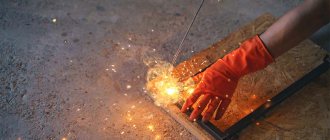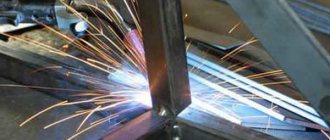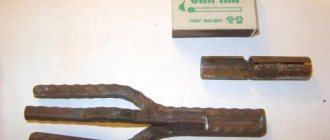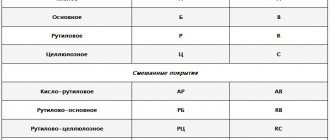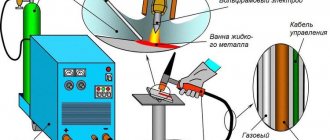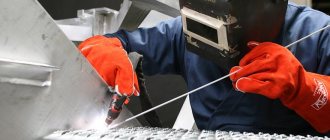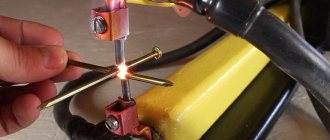The article, to help a novice welder, provides information on choosing a welding electrode for manual welding, choosing an inverter and welding mode - welding current, polarity.
Often, a novice welder faces many questions - which electrode to choose from the many brands and types on the market, how to connect an inverter, what current to use during the welding process, etc.
The welding electrode consists of two main parts - the core and the coating of the core - coating. The core melts during the welding process, and the coating burns, creating a protective gas layer (protection from oxygen). Electrode cores are made of various materials, depending on the metal being welded. There are electrodes for working with carbon, alloy, high-alloy steel, stainless steel, non-ferrous metals and their alloys. When choosing an electrode, first of all, we pay attention to the fact that the core material, in its composition, should be close to the metal being welded.
Types and purpose of welding electrodes
With welding you can:
- connect metal parts;
- manufacture metal structures of any size;
- cut metal;
- eliminate cracks;
- cut round and shaped holes;
- weld metal to restore wear areas;
- carry out repairs and other types of work.
The industry produces many types of electrodes, about two hundred of them. Each of them is most effective within the limited characteristics of these works, so the choice of electrodes for welding is a very important step. It should be done after thoroughly studying the topic or with the help of specialists.
The criteria for selecting electrodes are the design parameters, characteristics and purpose specified by the product manufacturer. The main ones are:
- electrode brand;
- appointment;
- core diameter;
- type of electrode coating;
- electrode length;
- the magnitude of the working current;
- type of current and polarity of connection;
- composition of the central rod;
- welding position;
- special technological characteristics of the welding process.
Material and types of coating
The electrode coating, based on the ratio of the total diameter of the electrode to the diameter of the core, is divided into the following categories (coefficient):
- Type M – thin coating (up to 1.2).
- C – average (up to 1.45).
- D – thick (up to 1.8).
- G – especially thick (over 1.8).
There is also a separate classification based on composition:
- A – sour.
- B – basic.
- C – cellulose.
- R – rutile.
- Two letters (mentioned above, as well as rutile-iron with the designation RZH) are a mixed type.
- P – other types.
The given letters are involved in the marking.
NOTE:
There is an additional division of electrodes into several groups, depending on the condition of the coating and the accuracy of manufacturing of these products.
Color
Tungsten electrodes are separately color-coded, indicating the type and percentage weight of the oxide contained in the composition:
- Thorium – blue (0.35 – 0.55%), yellow (0.8 – 1.2%), red (1.7 – 2.2%), lilac (2.8 – 3.2%), orange (3.8 – 4.2%).
- Zirconium – brown (0.15 – 0.5%) and white (0.7 – 0.9%).
- Lanthanum oxide – black (0.9 – 1.2%), gold (1.4 – 1.6%), blue (1.8 – 2.2%).
- Cerium oxide – gray, corresponding to 1.8 – 2.2%.
Lilac and turquoise colors indicate mixed oxides consisting of rare earth elements. Green rods are made from pure tungsten.
Purpose
The brand of the electrode, as a rule, encrypts its purpose. For example, product types:
- UONI - designed for welding parts at low temperatures;
- ANO-21 - for performing work with thin (up to 4 mm) parts operated under low pressure;
- MP-3S - for welding rolled parts and medium-carbon steels up to 20 mm thick;
- LEZ - for surfacing worn parts;
- inexpensive universal-use OZS-12 electrodes are recommended for welding carbon steels and are easy to use;
- rutile products of the ANO-4 grade are used for welding low-alloy and low-carbon steels; work on both direct and alternating currents; They cook metal contaminated with rust well, have a stable arc, and are easily cleaned of slag.
Experts distinguish between electrodes for welding, tacking, surfacing and cutting. Universal products are in great demand, saving a lot of time when performing various types of work.
By type of metal being welded
It is necessary to select electrodes for RDS welding according to the type of metal being welded.
Then the composition of the rod will be as close as possible to the composition of the main product and the connection will be homogeneous. The likelihood of cracks or temperature deformations due to differences in linear expansion, thermal conductivity, and impact strength will be reduced. For example, when welding cast iron with mild steel electrodes, many pores are created as carbon escapes from the weld pool. Steel also cools faster than cast iron, so after welding, cracks along the seam are possible. The use of special electrodes, such as ESAB OK 92.58 NiFe-Cl-A, made of an iron-nickel alloy makes the connection more viscous and resistant to tearing.
Video source: Aurora Online Channel
Depending on the workpieces to be welded, select electrodes for:
- low-carbon and low-alloy steels;
- alloy steels (stainless steel);
- cast iron;
- high carbon steels;
- aluminum
Diameter
The choice of electrode (core) diameter is determined by the thickness of the parts being welded and the maximum current of the welding machine used. The higher they are, the thicker the connected elements can be.
All three parameters are dependent on each other. Their values are indicated in special tables, which are convenient to use before work and purchasing electrodes. So, for parts with a thickness of 3-4 mm, you need to use electrodes with a diameter of 3 mm with adjustable operating current within the range of 80-160 A.
Electrode diameter
E42A-UONI-13/45-3.0
-UD ———————————— E432(5)-B 1 0
The next thing in the marking is the diameter of the metal rod. The value is indicated in millimeters with tenths, separated by commas. The electrode cross-section is selected based on the thickness of the workpieces being welded and the welding current. Electrodes that are too thin will quickly burn and spatter the filler metal, while electrodes that are too thick will create additional resistance and make the welding poor due to the shallow penetration depth.
Coating of electrodes
The core coating is a solid composition, a kind of flux, designed to protect the molten metal from the harmful effects of oxygen, which, when it enters the liquid metal, forms oxides that deteriorate the quality of the connection.
Another function of the coating is to thermally insulate the melt to delay the solidification time (so that harmful gas and non-metallic inclusions have time to escape from it). Modern electrodes use several types of coating. The main ones are basic (in the marking of electrodes, indicated by the letter “B”) and rutile (letter “R”).
Basic coating
It is known that it contains calcium salts - carbonate and fluoride. Its advantage is considered to be a low hydrogen content. Typical representatives of electrodes with basic coating are UONI products. Their coating ensures a high-quality seam, both in appearance and in technical indicators: ductility, strength, impact strength.
The electrodes do not form crystalline cracks inside the seam, therefore they are recommended by specialists for critical welding operations and for products operated in harsh climatic conditions. They can be used when welding in any position except vertical.
Types of electrodes
E42A
-UONI-13/45-3.0-UD ———————————— E432(5)-B 1 0
The marking consists of a group of letters and numbers, behind which there are certain characteristics. For clarity of explanation, let’s take as an example common electrodes with the following markings:
The first indices E42A indicate the type of consumable element. There are several of them and they explain to the welder which metal is best welded with certain electrodes.
| Surfacing of the surface layer of metal | E-10, E-10G3, E-12G4, E-15G5, E-16G2ХМ, E-30G2ХМ - in total there are 38 types of this group |
| Welding structural carbon and low alloy steel | E38, E42, E46, E50, E55, E60 |
| Welding of carbon and low-alloy steels with increased requirements for impact strength and weld ductility | E42A, E46A, E50A |
| Welding of alloy structural steels | E70, E85, E100, E125, E150 |
| Welding of high-alloy structural steels | E-12X13, E-06X13N, E-10X17T, E-12X11NMF, E-12X11NVMF |
| Welding heat resistant steel | E-09M, E-09MH, E-09X1M, E-05X2M, E-09X2M1, E-09X1MF, E-10X1MNBF, E-10X3M1BF, E10X5MF |
In our example, type E42A is indicated, where:
- E - electrodes for RDS.
- The number 42 is the tensile strength, measured in kg per mm?.
- A - the weld metal will have increased ductility and impact strength.
Thanks to knowledge of this part of the marking, you can easily select electrodes based on the strength of the seam - the higher the number, the stronger the connection. For example, in our case, 42 means that the welded seam will withstand a load of 42 kg per 1 square millimeter. When resistance to sudden loads is required, choose consumables with the prefix “A” in the type.
Rutile coating
Rutile is titanium dioxide. In addition to it, the coating contains silicon and oxygen.
Rutile coating is characterized by the following properties:
- formation of a high-quality seam at any spatial position of the electrode;
- stable arc burning;
- minimal splashing of melt and coating;
- possibility of welding on both direct and alternating currents;
- possibility of welding rusty and dirty parts;
- quick and easy ignition of the electrode;
- easy removal of slag.
Advantages of MP-3
Welding with MP-3 electrodes with rutile coating is considered the most environmentally friendly and safe in terms of the release of toxic compounds into the air, so work can be performed in closed, poorly ventilated rooms. Among other advantages:
- good first and re-ignition;
- stable burning of the electric arc (arc – medium, short or extremely short);
- unhindered separation of slag crust;
- low percentage of spattered metal;
- the ability to weld parts of large thickness;
- high-quality, durable, intergranular corrosion-resistant seam.
Like any others, rutile-coated electrodes of the MP-3 brand must be stored in a dry room at a temperature not lower than +15 °C. The permissible moisture content in the coating is 1%. If this indicator is exceeded, the electrode requires calcination for an hour at a temperature of 150-180 °C.
Current source
To weld metals with electrodes, welding transformers, rectifiers, inverters and other devices operating in manual arc welding mode are used. The inverter is widely used due to its compactness, light weight and wide capabilities.
It provides operation on both direct and alternating current, and its light weight is explained by the fact that voltage transformation is performed at a frequency not of 50 Hz, but of 100 kHz, for which the size and weight of the transformer core is reduced by an order of magnitude.
When welding with direct current, the polarity of the connection matters. With direct polarity, the ground (welding part) is connected to the “+” of the source, and the holder with the electrode is connected to “-”. With reverse polarity, the opposite is true. With direct polarity you can weld thin parts, and with reverse polarity you can weld massive parts.
When selecting electrodes, using the table and data on the welding machine, you can determine whether the source can provide the required amount of current.
How to choose electrodes for inverter welding
First of all, the composition of the core is selected: it must be similar to the type of metal being welded. Structural steel is the most commonly used material in households. The electrodes should be made from the same wire. Sometimes you still have to cook stainless steel. Then the core should also be made of stainless steel, and for highly alloyed and heat-resistant ones it is made of metal with the same characteristics.
You can perform all the work around the house or at a construction site using just a few brands of electrodes:
- MR-3
- SSSI 13/55
- ANO 21
- OK 63.34
They are recognized by many as the best electrodes for beginners who work with inverter welding machines: they are easier to work with, at the same time, they allow you to weld high-quality seams even without significant experience. Below are the characteristics and general application of those consumables that many experts consider good electrodes for an inverter. In any case, they are often recommended for beginning welders to gain experience.
Electrodes with rutile coating MP 3
MP-3 is perhaps the most popular welding electrodes for inverters among beginners.
Most often, beginners are advised to start mastering welds with MP-3 electrodes. They light up easily, even with a not very good current-voltage characteristic of the welding machine, provide good protection for the weld pool, and make it quite easy to control its position. If the electrode does not ignite, calcine it at a temperature of 150-180° for 40 minutes.
They are used in devices with alternating current (welding transformers) and direct current (welding rectifiers and inverters). Inverters are usually connected with reverse polarity (+ on the electrode). Suitable for any type of seam, except vertical from top to bottom.
Read about the types of welding machines here.
MP 3 electrodes are not picky about the quality of the surfaces being welded. They can be used even on untreated, rusty and wet parts. Welding is carried out with a medium (2-3 mm) or short arc.
The MP 3 feature is very important for novice welders: they “hold” the arc well and are easy to work with. This is why not all professionals love this brand: they call them sparklers. They cook too softly: slow movements are necessary for good heating. What the pros don't like, is just what beginners need. Try to start learning welding with MP3. Everything should work out for you.
| Electrode diameter LEZ MR-3, mm | Length, mm | Recommended welding current, A | Pack weight, kg | Price, rub |
| 2,0 | 250 | 40-60 A | 1,0 | 146 |
| 2,5 | 300 | 60-100 A | 1,0 | 120 |
| 3 | 350 | 70-100 A | 1,0 | 95 |
| 4 | 450 | 80-170 A | 1,0 | 91 |
| 5 | 450 | 130-210 A | 1,0 | 91 |
UONI 13/55 with basic coating
Electrodes preferred by professionals for the UONI 13/55 inverter (click on the picture to enlarge the size)
These are, perhaps, the most widespread and popular electrodes with a basic coating. They are recommended for welding carbon and low-alloy steels. Suitable for connections of critical structures. The seams are resistant to shock loads and ductile, and withstand low temperatures well.
The disadvantage of these electrodes is that they ignite well only when the idle value of the inverter is sufficiently high (above 70 V). The second significant drawback: high requirements for stripping and processing of welded metals. If rust, dust, oil or other contaminants remain on the edge, the seam will be porous.
You can work with UONI 13/55 only on DC welding machines, including those with inverters, with reverse polarity (+ applied to the electrode), and with a short arc (keep the tip of the electrode closer to the surface to be welded). Minimum open circuit voltage 65 V.
| Electrode diameter UONI 13/55 (manufacturer: Mezhgosmetiz) | Electrode length, mm | Recommended welding current, A | Retail price of a pack, rub |
| 2,0 | 250 | 30-60 A | |
| 2,5 | 300 | 40-70 A | 127 RUR |
| 3 | 350 | 80-100 A | 116 RUR |
| 4 | 450 | 130-160 A | 111 rub. |
| 5 | 450 | 180-210 A | 110 rub. |
ANO 21
This type of rutile-coated electrode is designed to work with thin carbon steels. (Read about welding thin metals here.) When using them, the arc is easily ignited (including when re-igniting), the weld is fine-scaled (made up of small waves), and the slag is easily separated. ANO 21 electrodes can be used for welding water or gas pipes.
Try ANO 21 electrodes to work on the inverter
They work with both alternating and direct current of any polarity. Before welding, heat treatment is required: they are calcined at a temperature of 120°C for 40 minutes.
| Diameter, mm | Low electrode position | Vertical electrode position | Ceiling electrode position |
| 2 | current 50-90 A | current 50-70 A | current 70-90 A |
| 2,5 | current 60-110 A | current 60-90 A | current 80100 A |
| 3 | current 90-140 A | current 80-100 A | current 100-130 A |
Stainless steel electrodes OK 63.34
If you need to weld stainless steel, try OK 63.34. They can also cook structural steel. This produces a seam with a small wave with a smooth transition to the main surface of the metal. The amount of slag is small and can be easily removed.
This electrode is good for welding vertical seams in metal 6-8 mm, passing from top to bottom. Suitable for multi-pass welding of butt and overlap joints. Works with direct and alternating current of any polarity, minimum open circuit voltage is 60 V.
Welding electrodes OK 63.34
For welding you will also need a mask. To make your work easier, take a chameleon welding mask.
Welding position
The spatial position of the electrode is also included in its marking. The number 1 denotes electrodes that are used for welding only in the lower position of the part (electrode on top).
The number 2 marks products used with a horizontal or vertical seam (ceiling is excluded).
Number 3 is used for ceiling electrodes (the electrode rests on the part from below). The welder must take these markings into account to avoid a poor-quality weld or injury.
Calcination of electrodes
Coating of electrodes requires tightness during storage, but this condition is not met everywhere. The sharp edges of the rods, as a rule, break the tightness of the plastic packaging already during the first transfer of packs. Thus, by the time of purchase, the electrodes are saturated with excess atmospheric moisture.
In this condition, due to the danger of obtaining a poor-quality seam and the possibility of too much metal spattering, welding cannot be performed with them. The electrodes need to be dried. The manufacturer gives clear recommendations regarding process parameters, setting drying time and maximum temperature. It usually does not exceed 260 ºС.
How to determine the quality of electrodes when purchasing?
The best option would be to test several electrodes from the purchased batch in the welding workflow. If this is not possible, you need to pay attention to the following factors:
- shelf life of products;
- name of the manufacturing company (for experienced welders this is important information);
- quality of coating in terms of uniform thickness of application around the rod, absence of crumbling.
If during testing there are signs of excessive moisture, the electrodes should be dried and the test repeated.
In order for the welding of parts to be carried out in accordance with all the rules of the regulations, and the quality of the seam not to be criticized, it is extremely important to study welding technologies well. The choice of electrode type is an integral part of this knowledge, which needs to be constantly replenished and improved.
In this article:
The electrode in manual arc welding performs several functions at once. Firstly, an electric arc burns between the end of the rod and the product, which melts the edges of the metal. Secondly, the rod serves as a filler metal, gradually melting and adding to the weld pool. Thirdly, the electrode coating burns and releases protective gases that prevent air from entering the weld pool.
If you choose the electrodes correctly, the arc will be easily excited, burn evenly, and fewer drops of molten metal will scatter to the sides. The weld metal will be saturated with useful inclusions from the rod and electrode coating, which will contribute to the strength and other properties of the joint.
Errors when choosing a consumable will affect both the ease of use and the quality of the connection. But there are no universal electrodes suitable for all tasks. Many brands of consumables have been developed, differing in the composition of the rod, the composition of the coating, suitability for the type of current, spatial position, and intended for narrow use. We will look at how to choose welding electrodes for MMA welding based on all these parameters.
